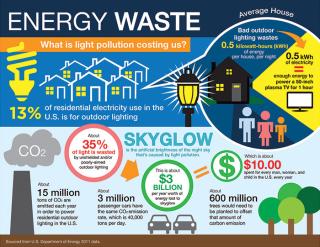Light Pollution

What is Light Pollution?
Light pollution is “the inappropriate or excessive use of artificial light.” There are three main types of light pollution – glare, skyglow, and light trespass.
Glare light pollution is a result of unshielded light that can cause harm to the eyes, especially as a person ages.
Skyglow refers to the bright halo that appears over urban areas at night which is a product of light being scattered by water droplets or particles in the air.
Light trespass is when unwanted artificial light spills onto an adjacent property and lights up an area that otherwise would be dark.
What are the Effects?
Light pollution may not appear at first as something that is a major threat to humans or to the environment – when in reality it has severe adverse effects and degrades environmental quality. Many researchers and environmentalists consider light pollution to be one of the fastest and more pervasive forms of environmental pollution.
Many migratory birds fly by night and the light from stars and the moon helps them navigate. They become disoriented by the glare of the artificial lights when they fly over urban and suburban areas.
Regarding humans, there are many health impacts. Humans are dependent on their body's natural cycle, which is regulated by light and dark. If humans are exposed to light while they are sleeping, the production of melatonin can be suppressed. This can create many problems including sleep disorders, headaches, fatigue, medically defined stress, and some forms of obesity that are caused by a lack of sleep and increased anxiety.
Not only does light pollution have adverse effects for humans and animals, it also increases energy consumption. About ¼ of energy consumption worldwide is from lighting. Lighting at night can result in over-illumination and lead to an excess of wasted energy. This is a waste in cost and increases the carbon footprint.
How Can You Help?
Light pollution is already a serious issue but that does not mean it is too late to try to reduce it. There are actions humans can take to try and decrease light pollution and help the environment. Only use light when and where it is absolutely needed. Use well-designed light fixtures that have modern optical controls so the light can be directed downward and use the minimum amount of wattage needed for the area to have sufficient lighting.
More information is available from the International Dark-Sky Association (IDA) at www.darksky.org

